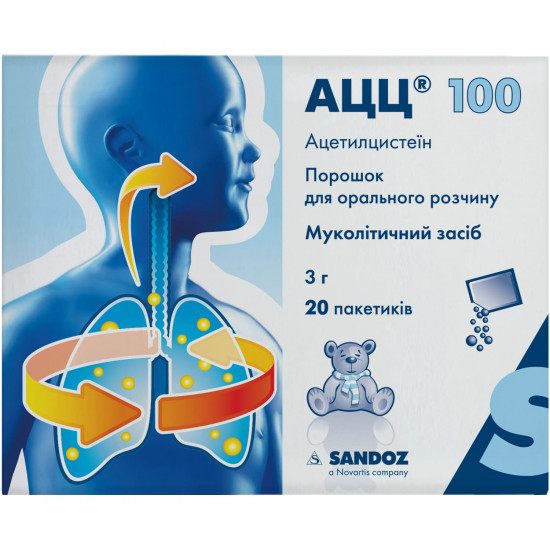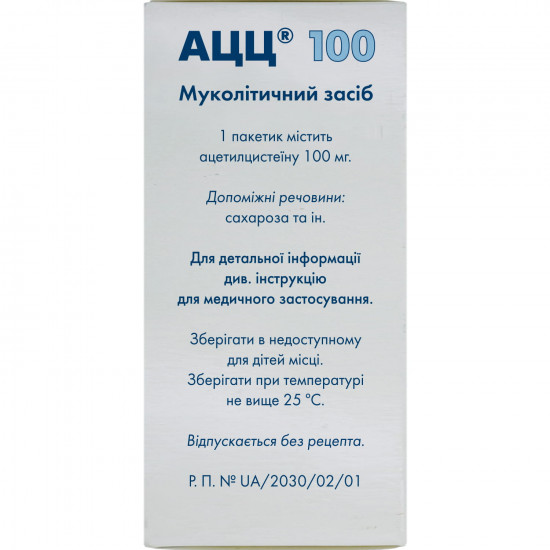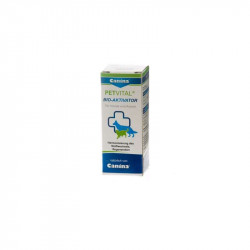



- Stock: In Stock
- Model: 178752
0% Customers recommend this product
-
5 Awesome0%
-
4 Great0%
-
3 Average0%
-
2 Bad0%
-
1 Poor0%
Reviews Over ACC of a time. for shouted. solution of 100 mg package No. 20
- (0)
Total Reviews (0)
click here write review to add review for this product.
Report this review.
Description
Pharmacological properties
Pharmacodynamics. Acetylcysteinum (azz) — the mucolytic, expectorant medicament used for fluidifying of a phlegm at the diseases of a respiratory system which are followed by formation of dense slime. Acetylcysteinum is derivative amino acids cysteine. the mucolytic effect of medicine has the chemical nature. at the expense of free sulfhydryl group Acetylcysteinum breaks disulfide bridges of acid mucopolysaccharides that leads to a depolymerization of mukoproteid of a phlegm and reduction of viscosity of slime and promotes expectoration and an otkhozhdeniye of a bronchial secret. medicine keeps activity in the presence of a purulent phlegm.
Acetylcysteinum has also antioxidant pneumotyre-tread properties that is caused by binding by its sulfhydryl groups of chemical radicals and, thus, their neutralization. Besides, medicine promotes increase in synthesis of glutathione — an important factor of intracellular protection not only against oxidizing toxins of exogenous and endogenous origin, but also from a number of cytotoxic substances. This feature of Acetylcysteinum gives the chance to effectively apply the last at paracetamol overdose.
Pharmacokinetics. After intake Acetylcysteinum quickly and completely is soaked up and exposed to metabolism in a liver with formation of cysteine, pharmacological an active metabolite and also diacetylcysteinum, cystine and further — the mixed disulfides. Bioavailability very low — about 10%. The C max in blood plasma is reached in 1–3 h after reception. Linking with proteins of blood plasma — 50%. Acetylcysteinum is emitted with kidneys in the form of inactive metabolites (inorganic sulfates, diacetylcysteinum).
T ½ is defined p mainly by fast biotransformation in a liver — ≈1 h. In case of depression of function of a liver of T ½
Indication
Treatment of the sharp and chronic diseases of a bronchopulmonary system demanding reduction of viscosity of a phlegm, improvement of its otkhozhdeniye and expectoration increases to 8 h
.Use
to Adults and children is aged more senior than 14 years appoint 400–600 mg of Acetylcysteinum the day divided into 1–3 receptions.
to Children at the age of 6–14 years is appointed on 400–600 mg/days divided into 2–3 receptions.
byto Children at the age of 2–6 years appoint medicine in a dosage of 100 mg on 200–400 mg/days divided into 2–3 receptions.
is recommended to take the Drug after a meal. To dissolve contents of a bag in ½ glasses of water, juice or cold tea. After preparation of solution it should be drunk quickly. In some cases in connection with existence in composition of medicine of the stabilizer — ascorbic acid it is possible to leave the prepared solution approximately on 2 h before its application. The additional use of liquid enhances mucolytic effect of medicine.
Period of treatment is defined by the doctor depending on character and a course of the disease (sharp or chronic). It is longer not necessary to use medicament 4–5 days without consultation with the doctor.
Contraindication
Hypersensitivity to Acetylcysteinum or any of medicine components. ulcer of stomach and duodenum in an aggravation stage, a pneumorrhagia, pulmonary bleeding, aggravation oh.
Side effects
For the description of frequency of side effects use the following classification: very often (≥1/10), it is frequent (≥1/100, 1/10), infrequently (≥1/1000, 1/100), single (≥1/10,000, 1/1000), is very rare (1/10,000), frequency is unknown (the obtained data do not give the chance to determine frequency).
from the immune system: infrequently — hypersensitivity; seldom — an acute anaphylaxis, anaphylactic/anaphylactoid reactions.
from blood and lymphatic system: frequency is unknown — anemia.
from nervous system: infrequently — a headache.
from an organ of hearing and a labyrinth: infrequently — a ring in ears.
from a cardiovascular system: infrequently — tachycardia, arterial hypotension; seldom — hemorrhages.
from a respiratory system: single — short wind, a bronchospasm (mainly at patients with hyperreactivity of the bronchial system which is associated with OH); frequency is unknown — a rhinorrhea.
from a digestive tract: infrequently — vomiting, diarrhea, stomatitis, an abdominal pain, nausea; seldom — dyspepsia; frequency is unknown — an unpleasant smell from a mouth.
from skin and hypodermic fabrics: infrequently — urticaria, rash, a Quincke's edema, an itch; frequency is unknown — rash, eczema, a Quincke's disease.
General violations: infrequently — a hyperthermia; frequency is unknown — a face edema.
toit was Very seldom reported about separate heavy reactions from skin (Stephens's syndromes — Johnson and Layell). In most cases at least one more medicine can be the cause of emergence of a skin and mucous syndrome more likely. Therefore at emergence of any new changes on skin or mucous membranes it is necessary to see a doctor and to immediately cancel use of Acetylcysteinum.
were Noted by cases of decrease in aggregation of platelets, but the clinical value of it is not defined.
Special instructions
Are separate messages about heavy reactions from skin (Stephens's syndromes — Johnson and a layell) at intake of Acetylcysteinum therefore in case of changes from skin or mucous membranes it is necessary to stop immediately use of medicine and to consult with the doctor of rather further reception.
Is recommended to take with care the medicament to patients with ulcer of stomach and duodenum in the anamnesis, especially in case of the combined intake of other medicines which irritate a mucous membrane of a stomach.
should use Drug with care at patients with OH because of possible development of a bronchospasm. In a bag contents rash in ware in preparation time of solution powder can get to air and irritate a mucous membrane of a nose owing to what there can be a reflex bronchospasm.
to Patients with diseases of a liver, kidneys should appoint Acetylcysteinum bywith care in order to avoid accumulation of nitrogen-containing substances in an organism.
Acetylcysteinum Use, generally in an initiation of treatment, can cause fluidifying of a bronchial secret and increase in its volume. If the patient is incapable to cough up effectively a phlegm, the postural drainage and a bronkhoaspiration are necessary.
Acetylcysteinum influences metabolism of a histamine therefore patients should not appoint long therapy with intolerance of a histamine as it can lead to emergence of symptoms of intolerance (a headache, vasomotorial rhinitis, an itch).
Light sulfuric smell is not sign of change of medicine, and is specific to active ingredient.
Drug contains sucrose therefore it patients should not appoint with rare hereditary forms of intolerance of fructose, deficiency invertases-isomaltases or a syndrome of glyukozo-galaktozny malabsorption.
One bag of ACC ® 100 contains2.8 g of sucrose (about 0.24 grain units), one bag of ACC ® 200 contains 2.7 g of sucrose (about 0.23 grain units). It should be considered at use of medicine for patients with diabetes.
Use during pregnancy and feeding by a breast. Pregnancy. Clinical data on use of Acetylcysteinum for pregnant women are limited. Researches on animals did not reveal straight lines or indirect negative impacts on pregnancy, embriofetalny development, childbirth and post-natal development.
Feeding by a breast. Information on penetration into breast milk is absent.
it is necessary to Take the medicament during pregnancy and feeding by a breast only after careful assessment of a ratio advantage/risk.
Children. Powder on 100 mg is applied at children aged from 2 years, powder on 200 mg is applied at children aged 6 years are more senior.
Ability to influence speed of response at control of vehicles or work with other mechanisms. Does not influence.
Interaction
Researches of interactions were conducted only with participation of adults.
Use together with Acetylcysteinum of antibechics can increase stagnation of a phlegm because of reduction of expressiveness of a tussive reflex.
Activated carbon reduces efficiency of Acetylcysteinum.
At simultaneous application with such antibiotics as tetracyclines (except doxycycline), ampicillin, Amphotericinum B, cephalosporins, aminoglycosides, their interaction with thiol group of Acetylcysteinum is possiblethat leads to decrease of the activity of both medicines. Therefore the interval between intake of these medicines has to make not less than 2 h. It does not concern a tsefiksim and a lorakarbef.
byAt a concomitant use of nitroglycerine and Acetylcysteinum revealed considerable hypotension and expansion of a temporal artery. In need of simultaneous use of nitroglycerine and Acetylcysteinum for patients it is necessary to control hypotension which can have difficult character, and it is necessary to warn them about possibility of a headache.
Atsetiltsistein can be the donor of cysteine and increase the level of glutathione which promotes a detoxication of free radicals of oxygen and certain toxics in an organism.
Acetylcysteinum reduces hepatotoxic action of paracetamol.
does not recommend to dissolvein one glass Acetylcysteinum with other medicines.
byAt contact with metals or rubber form sulfides with a characteristic smell therefore for dissolution of medicine it is necessary to use glasswares.
Influence on laboratory researches. Acetylcysteinum can influence a colorimetric research of salicylates and definition of ketone bodies in urine.
Overdose
Is not present data on overdose cases at oral administration of Acetylcysteinum.
Symptoms: the overdose can be shown by symptoms from a GIT, such as nausea, vomiting, diarrhea.
Treatment: there is no specific antidote at poisoning with Acetylcysteinum, therapy symptomatic.
Storage conditions
At a temperature not above 25 °C. to store out of children's reach.
Specifications
| Characteristics | |
| Active ingredients | Acetylcysteinum |
| Amount of active ingredient | 100 mg |
| Applicant | Sandoz |
| Code of automatic telephone exchange | R05CB01 Acetylcysteinum |
| Interaction with food | Later |
| Light sensitivity | Not sensitive |
| Market status | The branded generic |
| Origin | Chemical |
| Prescription status | Without prescription |
| Primary packing | bag |
| Producer | SALYUTAS PHARM GMBH |
| Quantity in packing | 20 bags |
| Release form | powder for internal use |
| Route of administration | Oral |
| Sign | Import |
| Storage temperature | from 5 °C to 25 °C |
| Trade name | ATSTS |















































